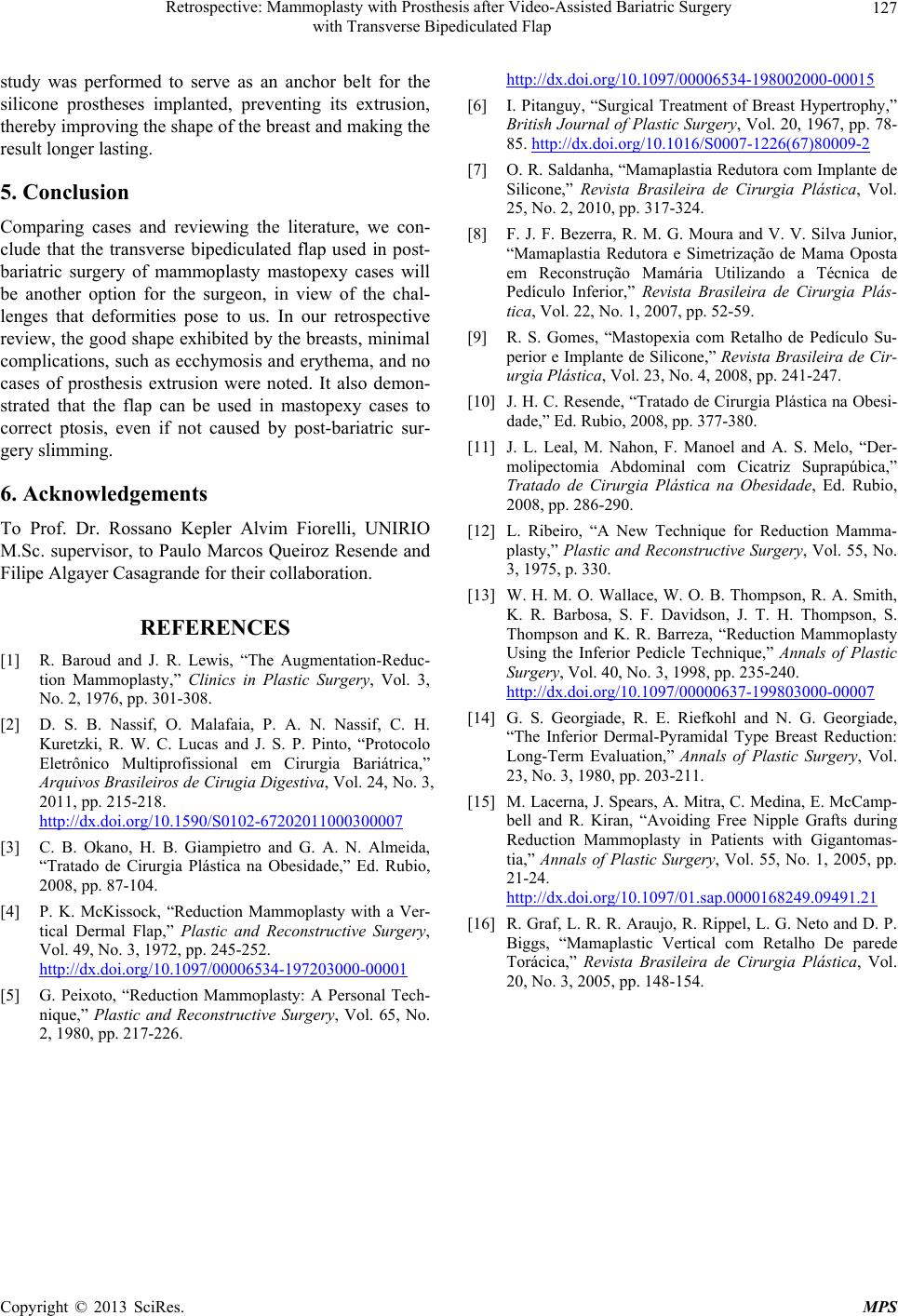
Retrospective: Mammoplasty with Prosthesis after Video-Assisted Bariatric Surgery
with Transverse Bipediculated Flap
Copyright © 2013 SciRes. MPS
127
study was performed to serve as an anchor belt for the
silicone prostheses implanted, preventing its extrusion,
thereby improving the shape of the breast and making the
result longer lasting.
5. Conclusion
Comparing cases and reviewing the literature, we con-
clude that the transverse bipediculated flap used in post-
bariatric surgery of mammoplasty mastopexy cases will
be another option for the surgeon, in view of the chal-
lenges that deformities pose to us. In our retrospective
review , the good shape ex hibited by the brea sts, minima l
complications, such as ecchymosis and erythema, and no
cases of prosthesis extrusion were noted. It also demon-
strated that the flap can be used in mastopexy cases to
correct ptosis, even if not caused by post-bariatric sur-
gery slimming.
6. Acknowledgements
To Prof. Dr. Rossano Kepler Alvim Fiorelli, UNIRIO
M.Sc. supervisor, to Paulo Marcos Queiroz Resende and
Filipe Algayer Casagrande for th eir collaboration.
REFERENCES
[1] R. Baroud and J. R. Lewis, “The Augmentation-Reduc-
tion Mammoplasty,” Clinics in Plastic Surgery, Vol. 3,
No. 2, 1976, pp. 301-308.
[2] D. S. B. Nassif, O. Malafaia, P. A. N. Nassif, C. H.
Kuretzki, R. W. C. Lucas and J. S. P. Pinto, “Protocolo
Eletrônico Multiprofissional em Cirurgia Bariátrica,”
Arquivos Brasileiros de Cirugia Digestiva, Vol. 24, No. 3,
2011, pp. 215-218.
http://dx.doi.org/10.1590/S0102-67202011000300007
[3] C. B. Okano, H. B. Giampietro and G. A. N. Almeida,
“Tratado de Cirurgia Plástica na Obesidade,” Ed. Rubio,
2008, pp. 87-104.
[4] P. K. McKissock, “Reduction Mammoplasty with a Ver-
tical Dermal Flap,” Plastic and Reconstructive Surgery,
Vol. 49, No. 3, 1972, pp. 245-252.
http://dx.doi.org/10.1097/00006534-197203000-00001
[5] G. Peixoto, “Reduction Mammoplasty: A Personal Tech-
nique,” Plastic and Reconstructive Surgery, Vol. 65, No.
2, 1980, pp. 217-226.
http://dx.doi.org/10.1097/00006534-198002000-00015
[6] I. Pitanguy, “Surgical Treatment of Breast Hypertrophy,”
British Journal of Plastic Surgery, Vol. 20, 1967, pp. 78-
85. http://dx.doi.org/10.1016/S0007-1226(67)80009-2
[7] O. R. Saldanha, “Mamaplastia Redutora com Implante de
Silicone,” Revista Brasileira de Cirurgia Plástica, Vol.
25, No. 2, 2010, pp. 317-324.
[8] F. J. F. Bezerra, R. M. G. Moura and V. V. Silva Junior,
“Mamaplastia Redutora e Simetrização de Mama Oposta
em Reconstrução Mamária Utilizando a Técnica de
Pedículo Inferior,” Revista Brasileira de Cirurgia Plás-
tica, Vol. 22, No. 1, 2007, pp. 52-59.
[9] R. S. Gomes, “Mastopexia com Retalho de Pedículo Su-
perior e Implante de Silicone,” Revista Brasileira de Cir-
urgia Plástica, Vol. 23, No. 4, 2008, pp. 241-247.
[10] J. H. C. Resende, “Tratado de Cirurgia Plástica na Obesi-
dade,” Ed. Rubio, 2008, pp. 377-380.
[11] J. L. Leal, M. Nahon, F. Manoel and A. S. Melo, “Der-
molipectomia Abdominal com Cicatriz Suprapúbica,”
Tratado de Cirurgia Plástica na Obesidade, Ed. Rubio,
2008, pp. 286-290.
[12] L. Ribeiro, “A New Technique for Reduction Mamma-
plasty,” Plastic and Reconstructive Surgery, Vol. 55, No.
3, 1975, p. 330.
[13] W. H. M. O. Wallace, W. O. B. Thompson, R. A. Smith,
K. R. Barbosa, S. F. Davidson, J. T. H. Thompson, S.
Thompson and K. R. Barreza, “Reduction Mammoplasty
Using the Inferior Pedicle Technique,” Annals of Plastic
Surgery, Vol. 40, No. 3, 1998, pp. 235-240.
http://dx.doi.org/10.1097/00000637-199803000-00007
[14] G. S. Georgiade, R. E. Riefkohl and N. G. Georgiade,
“The Inferior Dermal-Pyramidal Type Breast Reduction:
Long-Term Evaluation,” Annals of Plastic Surgery, Vol.
23, No. 3, 1980, pp. 203-211.
[15] M. Lacerna, J. Spear s, A. Mitra, C. Medina, E. McCamp-
bell and R. Kiran, “Avoiding Free Nipple Grafts during
Reduction Mammoplasty in Patients with Gigantomas-
tia,” Annals of Plastic Surgery, Vol. 55, No. 1, 2005, pp.
21-24.
http://dx.doi.org/10.1097/01.sap.0000168249.09491.21
[16] R. Graf, L. R. R. Arau jo, R. Rippel, L. G. Neto and D. P.
Biggs, “Mamaplastic Vertical com Retalho De parede
Torácica,” Revista Brasileira de Cirurgia Plástica, Vol.
20, No. 3, 2005, pp. 148-154.